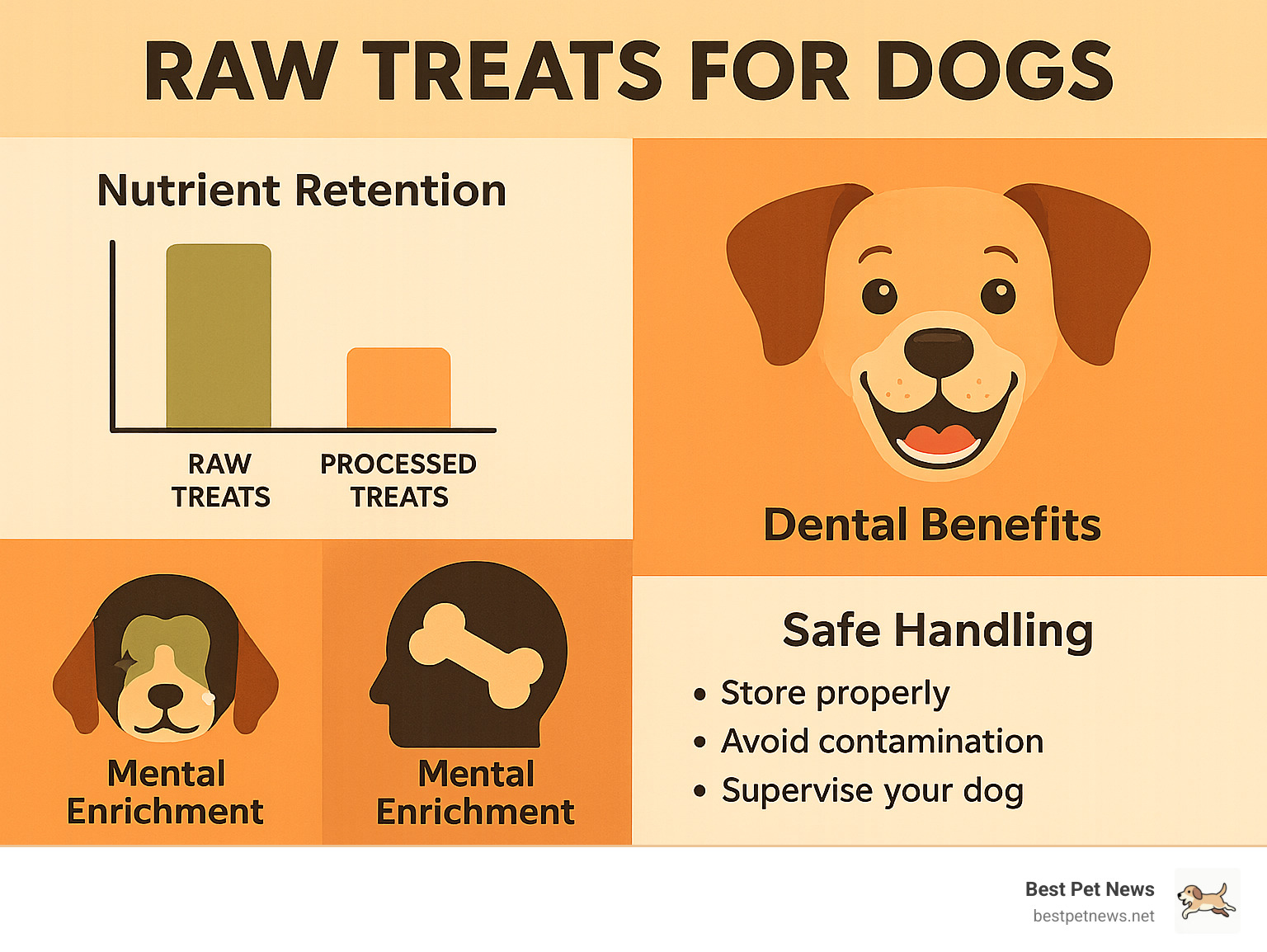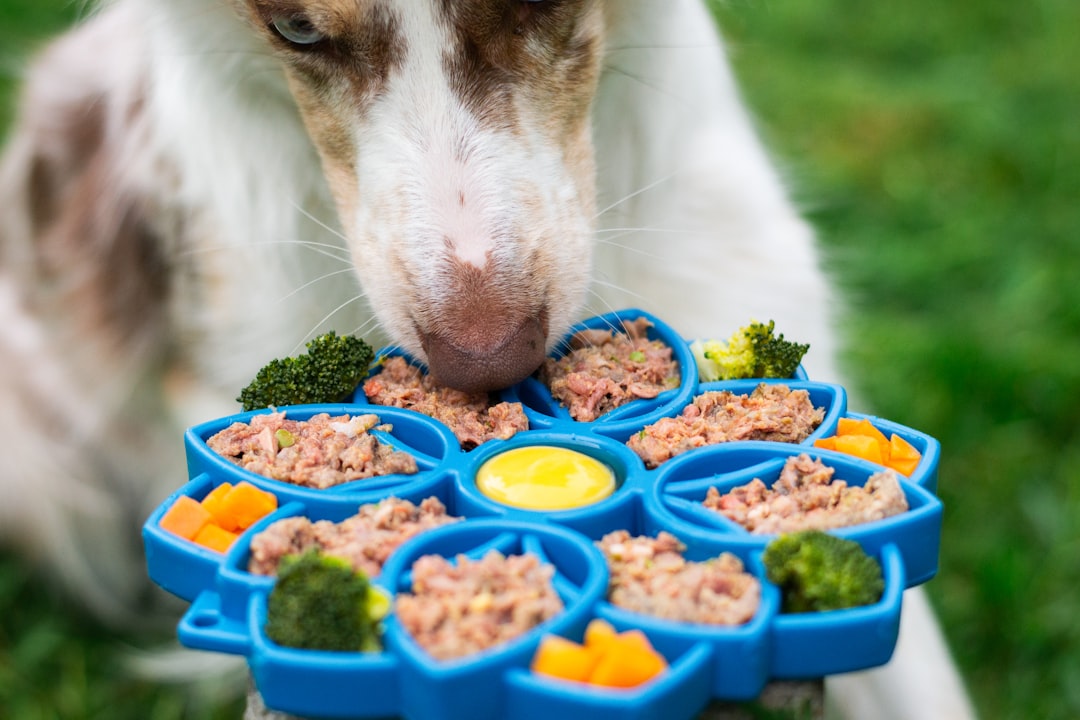Unleash the Flavor: 8 Best Raw Treats for Dogs

The Ultimate Guide to Raw Treats for Dogs
Raw treats for dogs are uncooked, minimally processed snacks that provide numerous health benefits compared to conventional treats. If you’re looking to buy raw treats for your dog, here are the top options to consider:
Best Raw Treats for Dogs at a Glance:
1. Raw meaty bones – For dental health and mental stimulation
2. Freeze-dried meat treats – Single-ingredient, nutrient-dense options
3. Dehydrated organ meats – Rich in vitamins and minerals
4. Raw goat milk products – Good for sensitive stomachs
5. Dried animal parts (tracheas, ears, feet) – Natural chews with joint benefits
Raw treats maintain their natural enzymes and nutrients that would otherwise be destroyed during cooking. They closely mimic what your dog’s ancestors would eat in the wild, supporting their natural dietary needs.
According to experts, raw treats can help reduce tartar and improve dental health, with studies showing that hard diets reduce plaque formation and gingivitis. They also provide mental enrichment by satisfying your dog’s natural chewing instincts.
Treats should make up no more than 5-10% of your dog’s daily caloric intake to maintain a balanced diet. Many commercial raw treats are made from USDA grass-fed, cage-free, antibiotic-free sources, ensuring high quality and safety for your pet.

Simple raw treats for dogs glossary:
– best treats for puppies
– feeding schedule for dogs
– pet nutrition tips
Why Choose Raw Treats?
Raw treats deliver advantages processed snacks can’t. Here are the big ones—backed by science and appreciated by countless happy pups:
- Dental health – Hard, abrasive textures scrape away plaque. Research in Odontologisk Revy shows harder diets significantly reduce plaque and gingivitis.
- Intact nutrients – Because they’re never cooked, vitamins, minerals and natural enzymes stay bio-available. Organ meats are especially rich in vitamin A, B-complex and iron.
- Primal chewing outlet – Dogs still carry wolf DNA. Chewing raw bones or tendons satisfies that instinct, releases calming endorphins and keeps boredom at bay.
- Mental enrichment – Long-lasting chews double as puzzles, cutting stress behaviours (see enrichment study).
- Weight-friendly – Most raw treats are pure protein with minimal carbs or sugars, fitting easily into calorie-controlled diets.
- Allergy relief – Single-ingredient options let you avoid common triggers and run elimination diets with confidence.
In short, raw treats work for teeth, tummy and temperament—all while giving your dog something they naturally love to do: chew.
Safety & Buying Guide for Raw Treats
A bit of knowledge keeps raw snacking both safe and beneficial.
Pathogen Control
Reputable makers use freeze-drying, air-drying, or high-pressure processing (HPP) to neutralise bacteria without heat. Choose brands that publish their testing protocols.
Read the Label
Single-ingredient treats are easiest on sensitive stomachs and make it simple to track calories. Look for USDA-inspected, grass-fed, antibiotic-free or “human-grade” wording.
Freeze-Dried vs. Air-Dried
Freeze-dried = light, crumbly texture and up to 98 % nutrient retention—great for training.
Air-dried = chewier, usually cheaper, ideal for longer gnaw sessions.
Calorie Cap & Sizing
Treats should stay below 10 % of daily calories. Match treat size to your dog and supervise bones to avoid choking.
Ingredient Red Flags
Skip artificial sweeteners (xylitol), added salt or seasonings, chemical preservatives, and cooked bones.
Homemade vs. Commercial
| Factor | Homemade | Commercial |
|---|---|---|
| Cost | Lower | Higher |
| Pathogen testing | None | Usually done |
| Convenience | Prep required | Ready to use |
| Shelf life | Short unless frozen | Long (freeze-dried) |
For more feeding guidance see our Pet Nutrition Tips.
The 8 Best Raw Treats for Dogs
When it comes to raw treats for dogs, variety isn’t just the spice of life—it’s essential for balanced nutrition and keeping your four-legged friend engaged. Our carefully selected lineup covers everything from training rewards to dental care solutions, all while maintaining optimal nutrient bioavailability and dental benefits.

Each treat on our list brings something unique to your dog’s snack rotation. We’ve included different protein sources, textures, and functional benefits to ensure there’s something for every pup—whether they’re food-motivated training champions, have dental health concerns, or simply deserve a special reward.
From meaty morsels that make perfect training rewards to substantial chews that keep your dog mentally engaged for hours, we’ve covered all the bases. You’ll find options spanning various animal proteins, organs, bones, and even dairy products.
The beauty of these raw treats for dogs is how they serve multiple purposes simultaneously—they’re not just delicious rewards but tools for better health and behavior. A single raw marrow bone, for instance, can clean teeth, provide essential nutrients, and keep your dog happily occupied for hours.
Let’s dig into each option to help you find the perfect raw treats for your furry companion.
1. Raw Marrow Bones – classic raw treats for dogs
Raw marrow bones are perhaps the most traditional raw treats for dogs – connecting our modern pups to their wild ancestors while delivering impressive health benefits.
Long-Lasting Chewing Satisfaction
Raw marrow bones are nature’s perfect solution for the dog who destroys toys in minutes. A good-sized bone can transform even the most energetic pup into a focused, contented chewer for hours. These natural chews are particularly wonderful for dogs with separation anxiety, high-energy breeds that need mental challenges, and teething puppies (with appropriate supervision).
Calcium and Mineral Boost
Raw marrow bones deliver an impressive nutritional punch. The bone itself provides calcium and phosphorus in nature’s perfect ratio – essential minerals your dog needs for strong teeth, healthy bones, proper nerve function, and blood clotting.
What makes these minerals special is their bioavailability – your dog’s body can easily recognize and use these nutrients in their natural state, unlike synthetic supplements.
Joint-Supporting Nutrients
The rich, fatty marrow contains collagen precursors that help maintain healthy joints, beneficial fats that aid in nutrient absorption, and bone marrow stem cells with potential anti-inflammatory properties.
Choosing the Right Marrow Bones
Always select bones larger than your dog’s muzzle to prevent choking hazards. Source matters too – bones from grass-fed, free-range animals typically contain more nutrients. Knuckle bones or femur cuts with the marrow intact offer the best combination of safety and enjoyment.
Supervision is essential with any raw bone. Once your pup has enjoyed the marrow and soft tissue, consider removing the emptied bone to prevent damage to teeth from excessive chewing on the hardened remains.
2. Freeze-Dried Beef Heart Cubes – high-value raw treats for dogs
Beef heart is a single-ingredient, nutrient-dense powerhouse packed with taurine, CoQ10, B-vitamins and highly-absorbable iron. In freeze-dried form it keeps 98 % of those nutrients and becomes a light, non-greasy training treat.
Why trainers love it:
* Breaks cleanly into pea-sized bits, so you can hand out dozens without over-feeding.
* Extremely high protein (≈60 %), virtually no carbs—perfect for weight-management plans.
* Irresistible aroma motivates even picky or distracted dogs.
Look for USDA-inspected, grass-fed sources and store opened bags in an airtight container for 30-45 days.
3. Dehydrated Chicken Necks
These crunchy chews pull double duty—scrubbing teeth while delivering natural glucosamine from cartilage.
Key perks:
* Dental care – The irregular shape acts like floss, scraping plaque before it hardens.
* Joint support – Glucosamine and chondroitin help maintain mobility.
* Convenient size – Fits most breeds; simply supervise small dogs.
Choose free-range, antibiotic-free necks that are gently dried with no added preservatives.
4. Raw Goat Cheese Bites
A creamy, novel dairy option that many lactose-sensitive dogs tolerate well.
Benefits at a glance:
* Probiotics & enzymes support a healthy gut.
* Easier to digest than cow dairy thanks to smaller fat globules and lower lactose.
* Summer treat – Freeze the bites for a cooling reward.
Alongside quality protein, each nibble supplies calcium and B-vitamins for strong bones and steady energy.
5. Frozen Goat Milk Yogurt Nuggets
Part snack, part hydration boost, these icy nuggets shine on hot days.
Highlights:
* Live cultures balance the digestive tract—70 % of a dog’s immune system sits there.
* Slow licking prevents gulping and helps lower body temperature after exercise.
* Easy DIY: spoon plain raw goat yogurt into silicone molds, freeze, serve.
Store homemade batches up to 3 months in the freezer.
6. Air-Dried Lamb Lung Strips
Feather-light yet flavorful, lamb lung is a favourite for waist-watching pups and sensitive stomachs.
Why pick lamb lung?
* Less than 5 % fat, 60-70 % protein—nutrient dense without excess calories.
* Strong aroma = stellar focus during training.
* Single ingredient, gentle drying—ideal for dogs with common protein allergies.
Select products labeled 100 % grass-fed lamb lung with no additives.
7. Whole Raw Sardine Snacks
Small fish, huge benefits.
- Omega-3 powerhouse – Raw sardines deliver EPA & DHA for joints, skin and brain.
- Shiny coat – Many owners report softer, glossier fur within weeks.
- Allergy friendly – An excellent novel protein for dogs that can’t handle chicken or beef.
Serve 1–2 small wild-caught sardines per week; thaw first or offer frozen for a crunchy chew.
8. Green Beef Tripe Bites
Yes, they smell—but dogs adore them and their gut will thank you.
Top advantages:
* Natural digestive enzymes and probiotics support microbiome balance.
* Picky-eater magic and high-value training reward thanks to that strong scent.
* Contains pre-digested plant nutrients, plus calcium and phosphorus.
Opt for true “green” (unbleached) tripe from grass-fed cattle and keep in a sealed container to contain the aroma.
Feeding, Storage & Handling Tips
Enjoying raw treats for dogs safely requires a bit of know-how when it comes to handling, storing, and serving these natural goodies.
Portion Control: The 5-10% Rule
Keep treats to 5-10% of your dog’s daily calories. For a medium-sized 50-pound dog eating about 1,000 calories daily, this means limiting treats to 50-100 calories total. On days when training sessions require more rewards, simply reduce your pup’s regular meals slightly.
A helpful trick is breaking larger treats into smaller pieces—your dog will still feel rewarded, but you’ll stretch your treat supply while keeping calories in check!
Safe Thawing Practices
Always thaw frozen treats in your refrigerator, never on the counter at room temperature where bacteria can multiply rapidly. Larger items like marrow bones may need a full 24 hours to thaw completely.
Once thawed, use treats within 2-3 days, and never refreeze raw items after they’ve been thawed. If your pup doesn’t finish a treat during a supervised session, discard anything that’s been left out for more than 30 minutes.

Cross-Contamination Prevention
Always wash your hands thoroughly before and after handling raw treats, and consider designating specific cutting boards and utensils just for pet food preparation.
After preparing raw treats, sanitize all surfaces with a mild bleach solution. Keep your dog’s raw treats stored separately from human food in the refrigerator or freezer, and be diligent about washing food bowls and cleaning feeding areas after each use.
Supervision During Chewing
Never leave your dog alone with raw treats, especially bones. Watch for overly aggressive chewing that might damage teeth, and remove treats once they become small enough to swallow whole. Stay alert for any signs of choking or distress.
Some dogs may become protective of high-value items like raw bones—if you notice resource guarding behaviors developing, it’s best to take the treat away and consult with a trainer.
Shelf Life Guidelines
Freeze-dried treats typically stay fresh for 12-18 months unopened in a cool, dry place. Once opened, use them within 30-45 days and store in an airtight container.
Raw frozen treats maintain quality for 6-12 months when stored at 0°F or below. Once thawed in the refrigerator, they should be used within 2-3 days maximum.
Raw bones deserve special attention—keep them frozen for up to a year, refrigerated for no more than 3-4 days, and discard after a single 1-2 hour chewing session.
For more options that align with natural feeding principles, our guide to Best Organic Pet Treats offers excellent alternatives.
Frequently Asked Questions about Raw Dog Treats
How often can I give raw treats?
Keep all treats—raw or not—at 5–10 % of daily calories. For a 50 lb dog (≈1,000 cal/day) that’s 50-100 cal from treats. Hard bones: once or twice a week; omega-3-rich fish: 1–2 times weekly; small freeze-dried bits can be daily in moderation.
Are raw treats safe for puppies, seniors or dogs with medical issues?
Yes, with adjustments. Puppies and seniors do best with softer items (e.g., freeze-dried meats, goat milk products). Avoid weight-bearing bones until growth plates close (12-18 months). Dogs with conditions like kidney disease or pancreatitis need veterinary guidance and lower-fat options.
Can I use raw treats for training?
Definitely. Freeze-dried single-ingredient meats or air-dried lung break into tiny pieces, are easy to carry and highly motivating. Cut to pea-size so you can reward often without overfeeding, and deduct those calories from meals.
Conclusion
Bringing raw treats for dogs into your furry friend’s life isn’t just about indulgence—it’s about enhancing their overall wellbeing in ways that conventional treats simply can’t match. From the primal satisfaction of a marrow bone to the training-perfect freeze-dried heart cubes, we’ve explored eight exceptional options that cater to different needs and preferences.
The beauty of these natural treats lies in their multifaceted benefits. While your dog enjoys the delicious flavor of a dehydrated chicken neck, they’re simultaneously cleaning their teeth, exercising their jaw muscles, and absorbing joint-supporting nutrients.
When introducing raw treats to your dog, patience is key. Start with small amounts and observe how your pup responds. Some dogs might need time to adjust, especially if they’ve only ever had processed treats.
Proper handling makes all the difference in keeping these treats safe and beneficial. Store them correctly, follow thawing guidelines, and always practice good hygiene to protect both your family and your pet. And while your dog might look at you with those irresistible pleading eyes, even the healthiest treats should make up no more than 5-10% of their daily calories.
Variety matters. Rotating between different raw treat types ensures your dog receives a broader spectrum of nutrients while keeping their interest piqued. Today’s marrow bone, tomorrow’s sardine, and next week’s tripe bite creates a diverse treat experience that supports different aspects of their health.
For dogs with specific health concerns or special needs, a conversation with your veterinarian before introducing raw treats can provide personalized guidance.
At Best Pet News, we believe that informed pet parents make the best decisions for their four-legged family members. We’re committed to providing you with trustworthy, practical information that improves your pet’s life. For more in-depth guides on nutrition, behavior, and wellness, visit our caring for your pet section.
Thank you for taking the time to learn about these natural, nutritious options for your canine companion. The extra effort you put into selecting quality treats reflects the love you have for your dog—and they’ll thank you with better health, brighter eyes, and that unmistakable tail-wagging joy that makes it all worthwhile!


